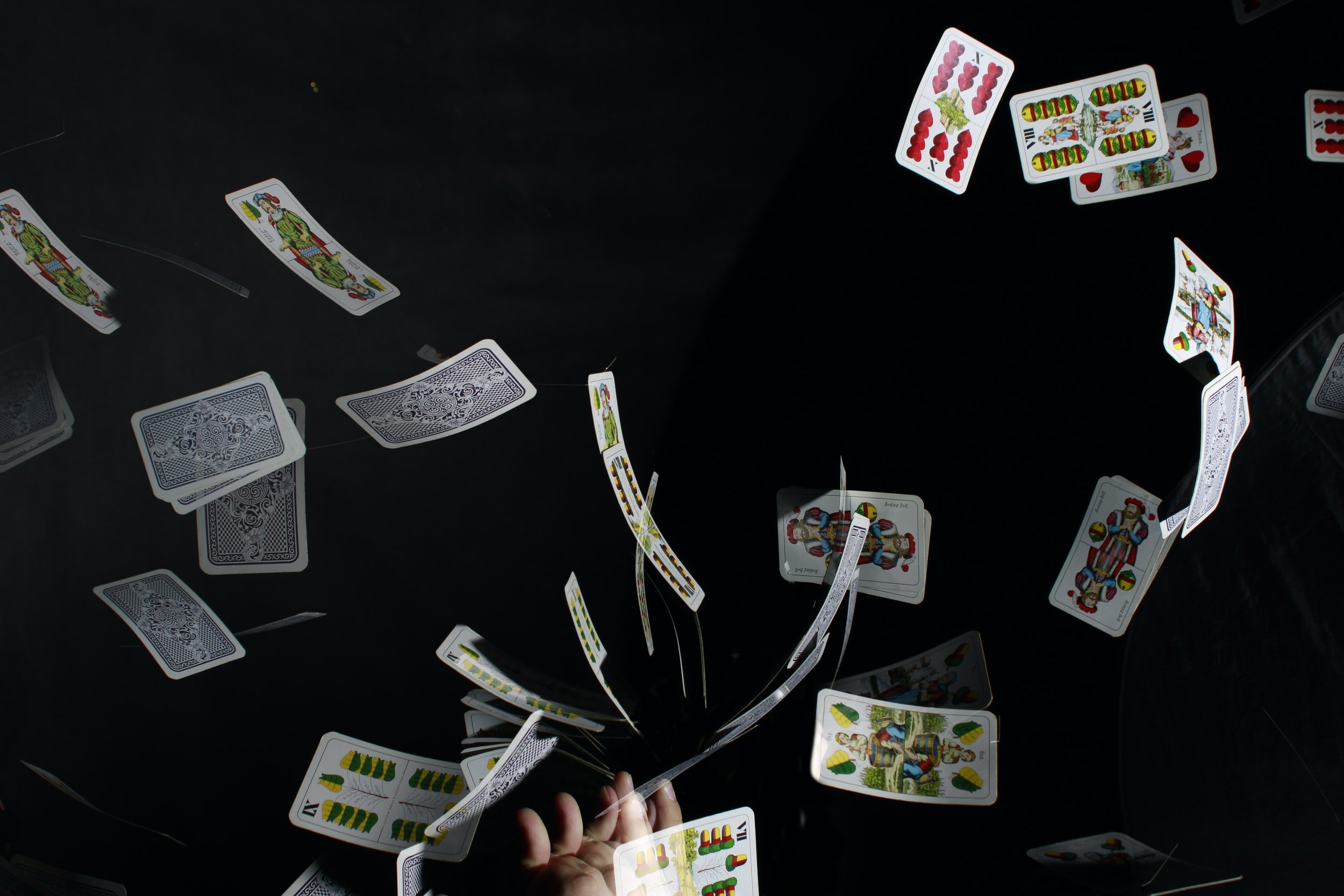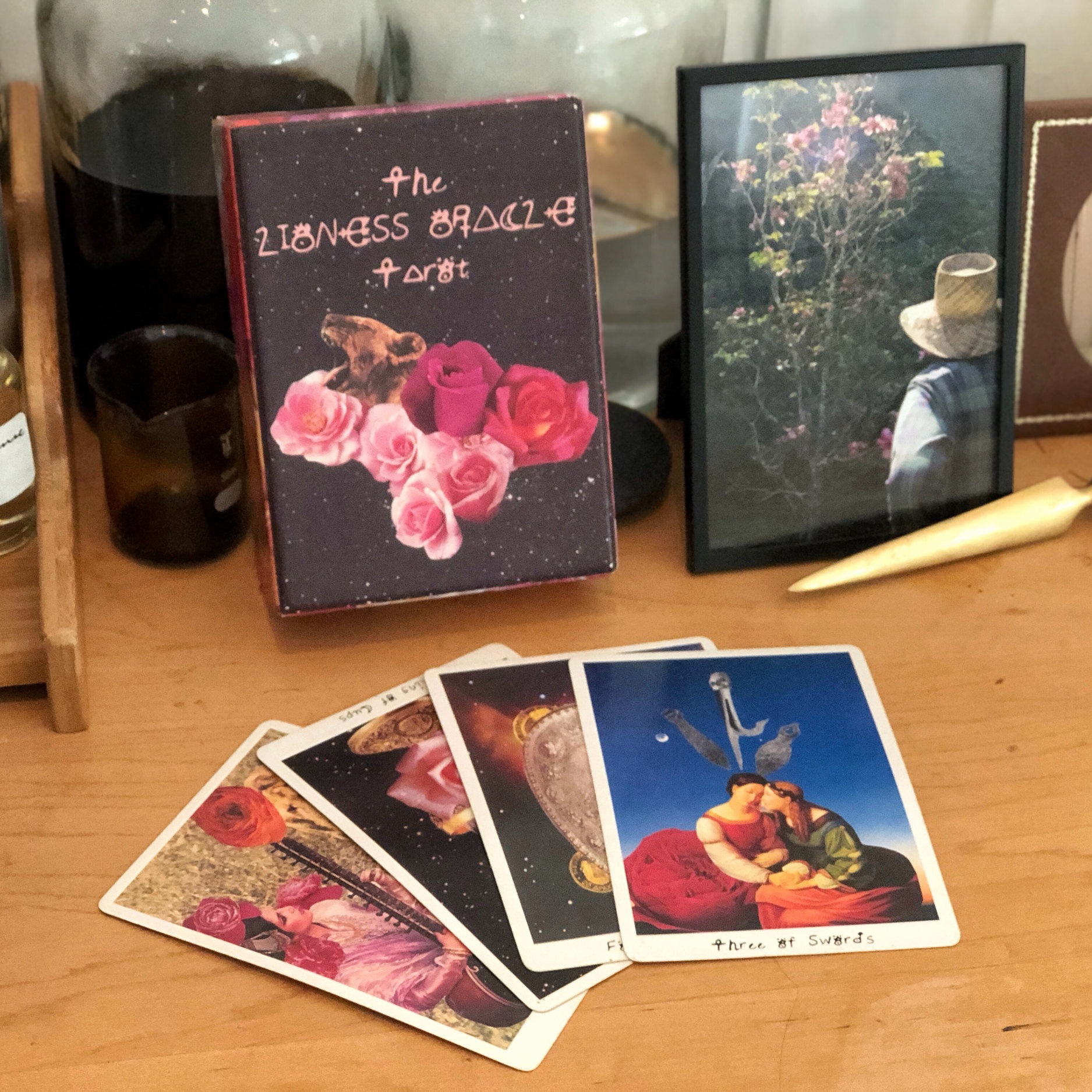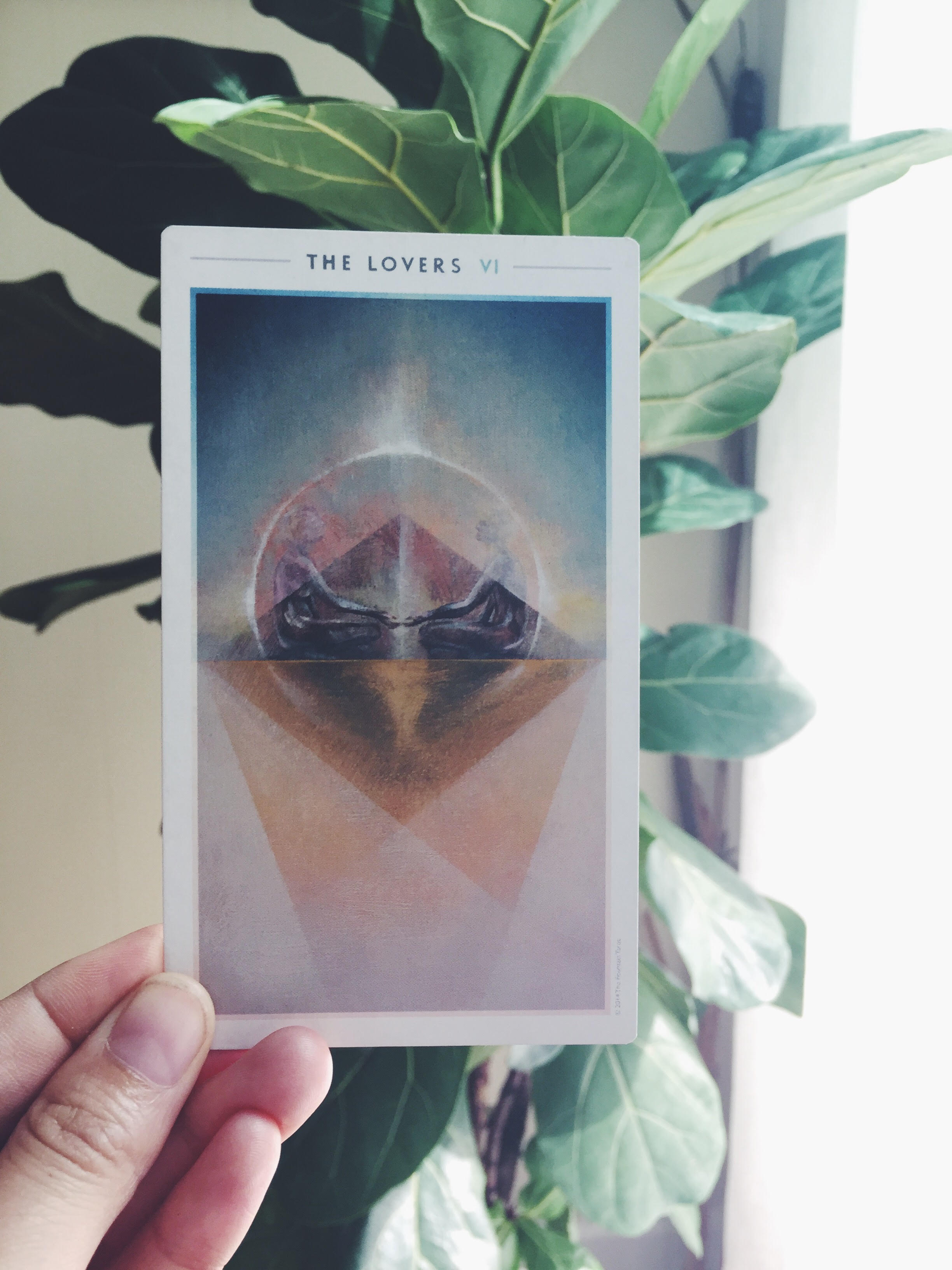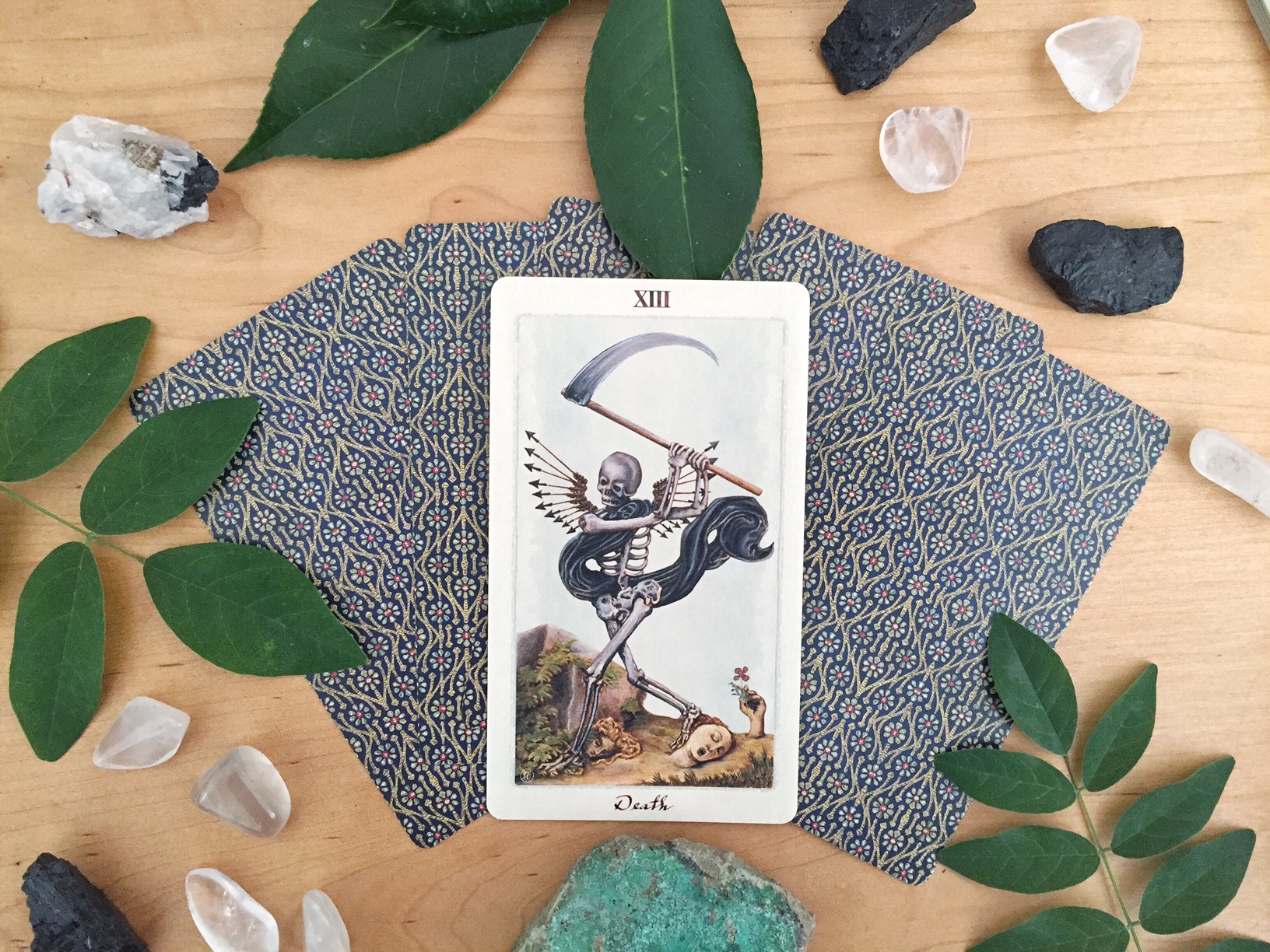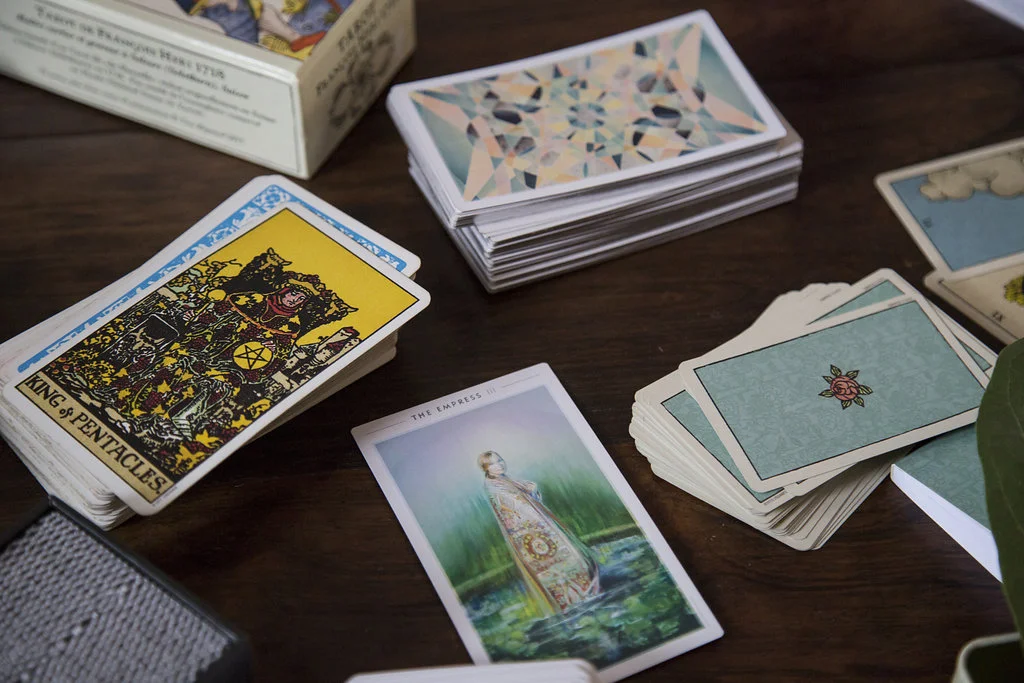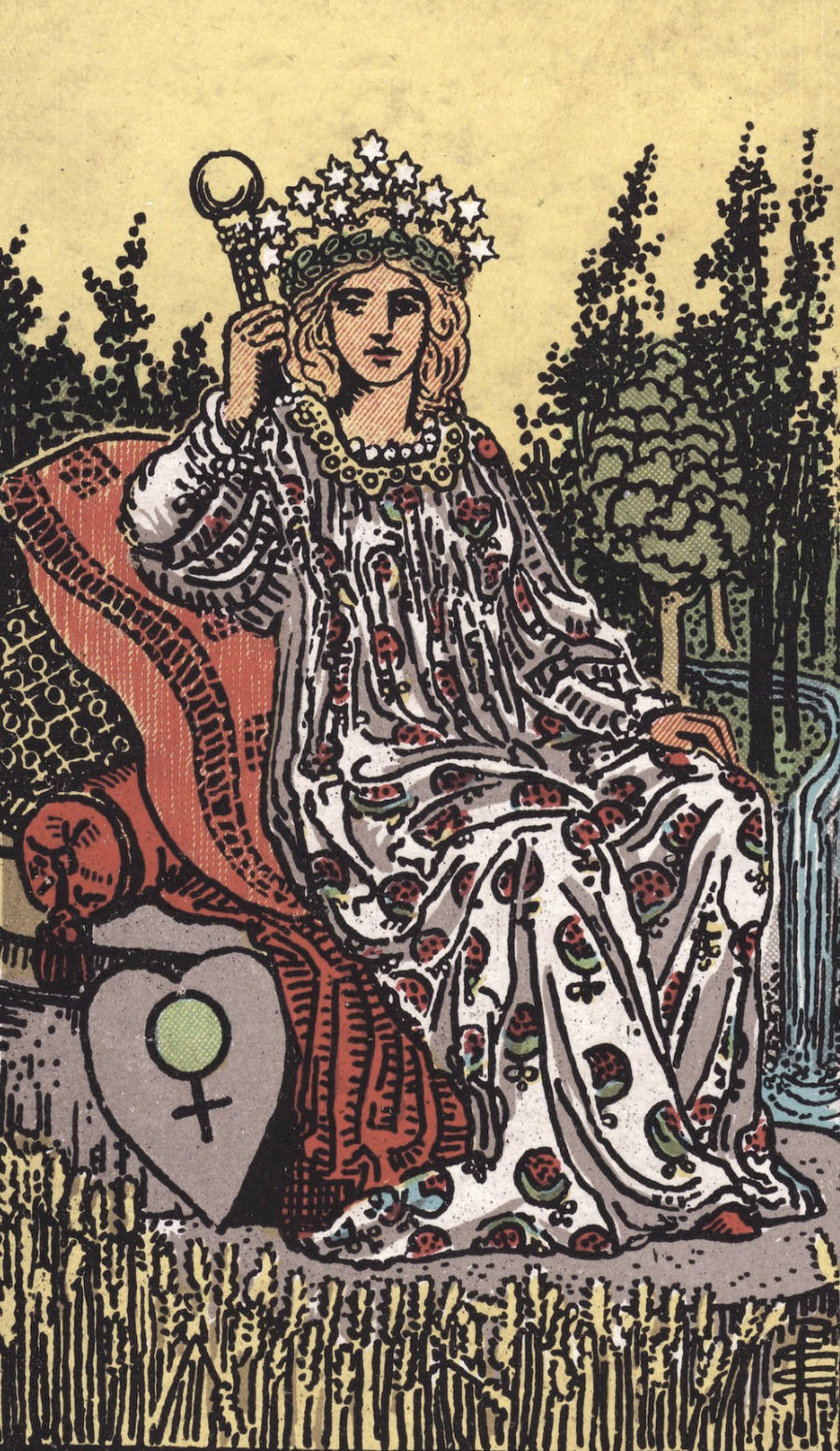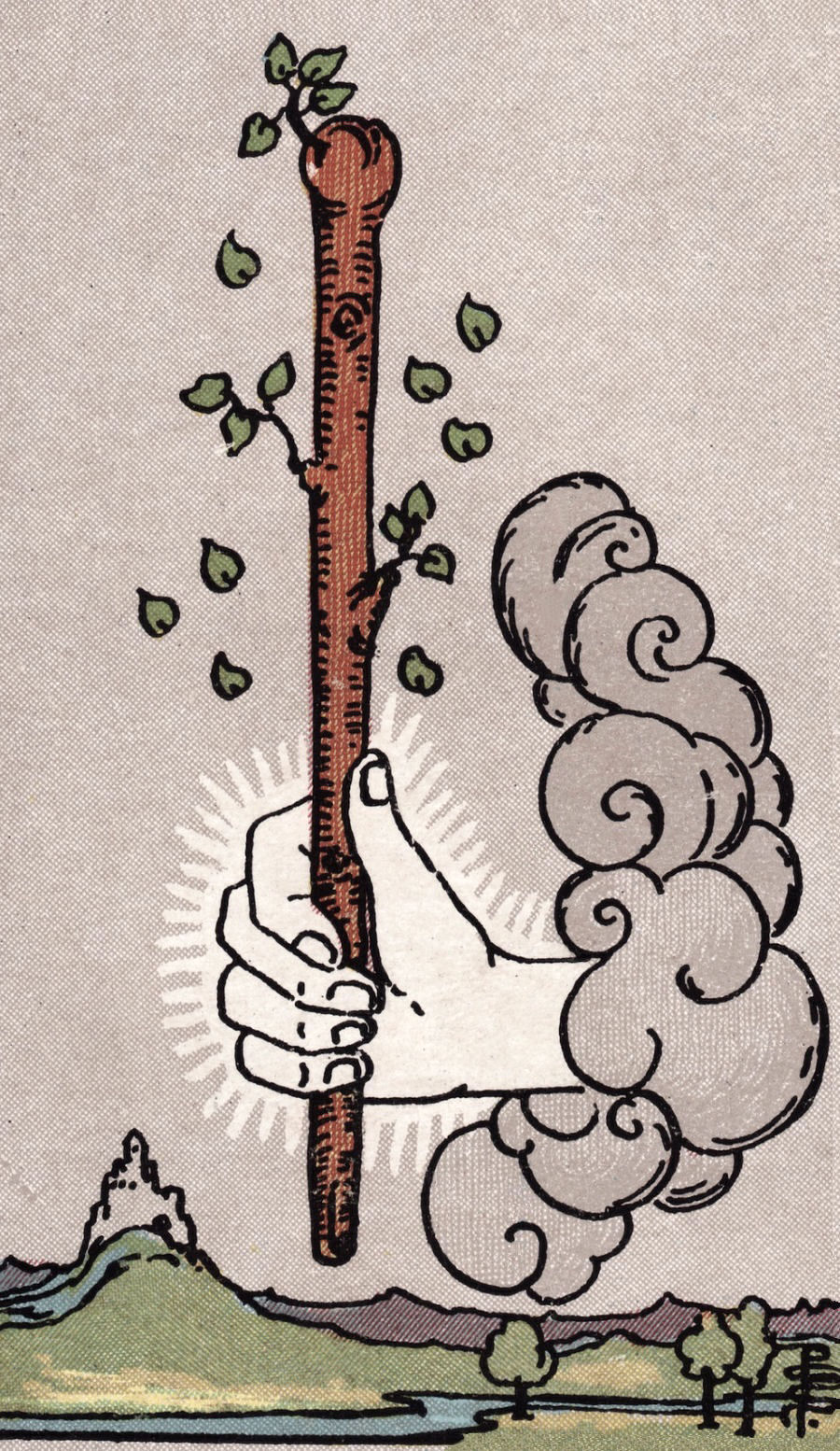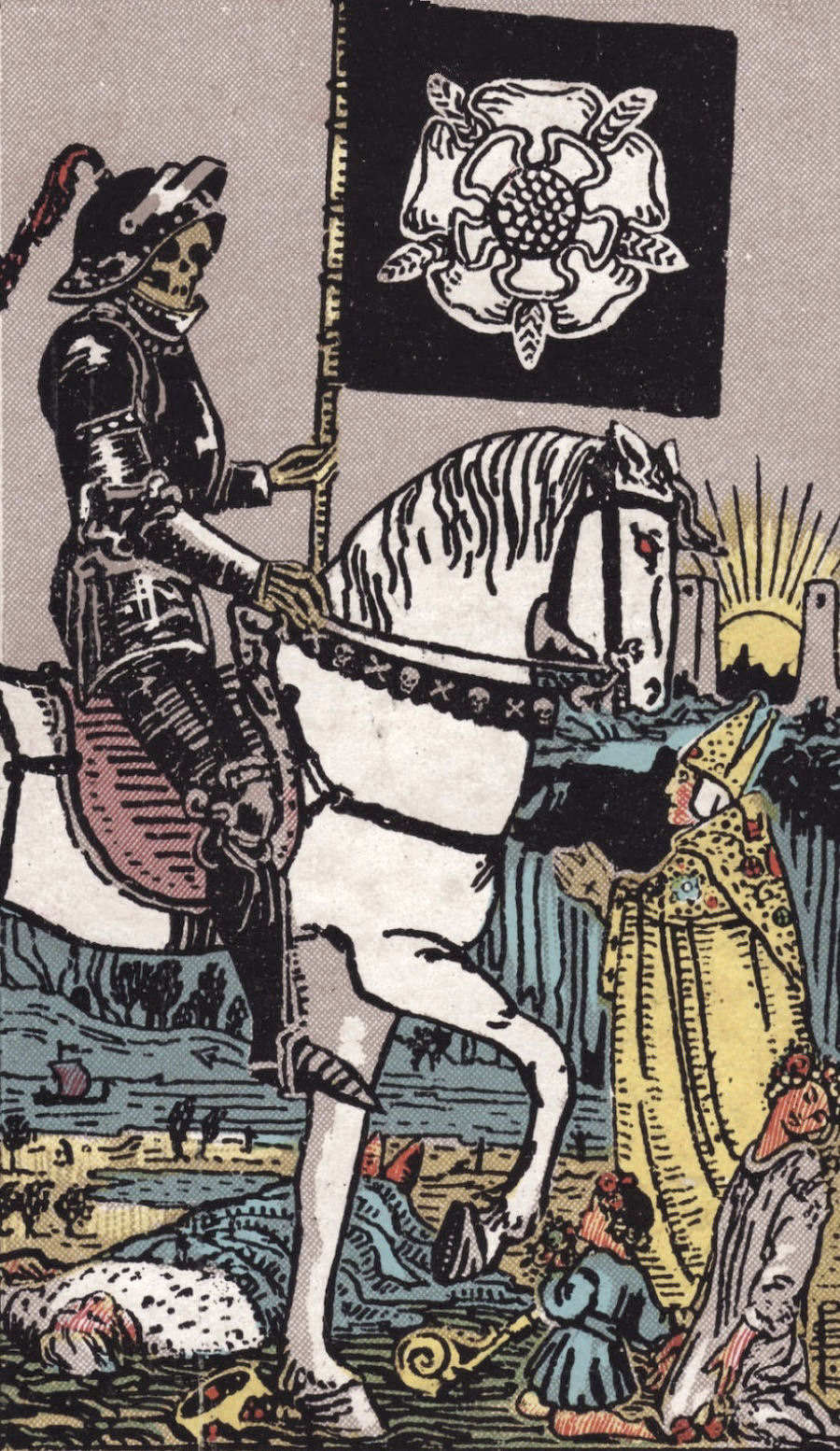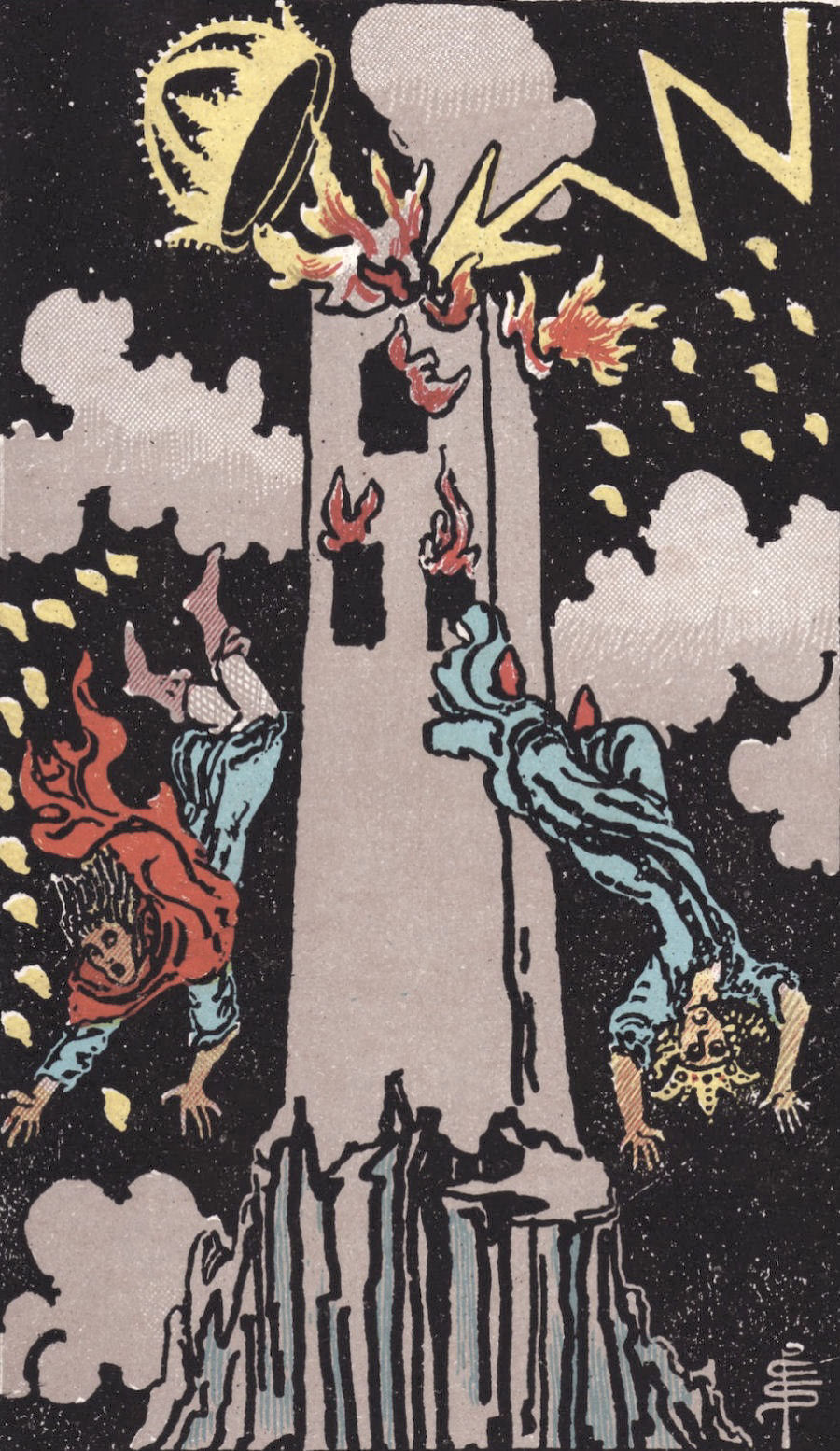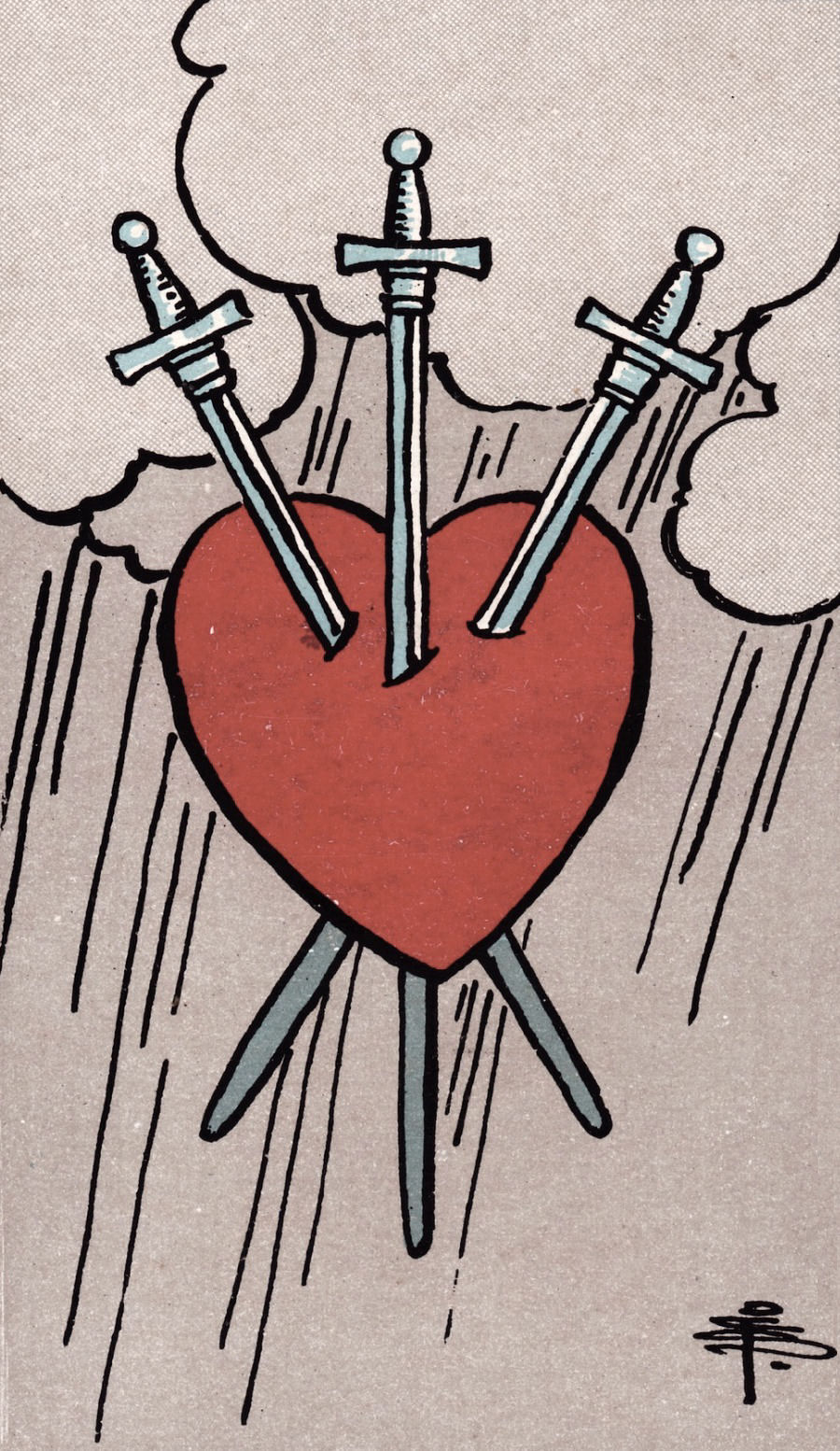Vulnerability + Tarot Readings
One of the surprising parts of attending the Readers’ Studio tarot conference this past week was that it involved lots of hands-on tarot practice. During each master class we’d all swap readings with each other, testing out our new techniques.
As a professional tarot reader, I don’t often find myself on the other side of the table. If I need a reading, I’ll often give one to myself (hey, it’s quite convenient!), so it was humbling and eye-opening to be on the receiving end.
One of the surprising parts of attending the Readers’ Studio tarot conference this past week was that it involved lots of hands-on tarot practice. During each master class we’d all swap readings with each other, testing out our new techniques.
As a professional tarot reader, I don’t often find myself on the other side of the table. If I need a reading, I’ll often give one to myself (hey, it’s quite convenient!), so it was humbling and eye-opening to be on the receiving end.
And here’s what really struck me:
Getting your cards read by another person is a very vulnerable experience.
Your questions, dreams, issues and more are all out on the table. And how often do we find ourselves the sole object of attention in our lives? You certainly do in a tarot reading! The space is all for you to unravel and explore whatever’s on your mind.
It’s healing, powerful, and much different that our usual mode of communicating “in real life.”
As the conference progressed I touched on many of the central questions in my life right now with multiple people. It was fascinating to see how this contact - getting ideas that are normally trapped in my head - transformed my thinking. Stuck areas started feeling ligter. My brain was moving in interesting new directions, and my emotions and body, too.
So if you find yourself receiving a tarot reading or are curious to try one, know that while it might feel intense at first to be on the spot, doing so with a trusted friend or expert is a beautifully transformative experience. It certainly was for me.
Can I Be Rational and Get a Tarot Reading?
You may be surprised with how many clients I get who feel nervous around tarot because they consider themselves skeptic, highly rational, and intellectual. It's a common fear that as soon as we dip our toes into the woo-sphere we're somehow going to have our "rational human being" card revoked. Believe it or not, I can personally relate to this feeling.
You may be surprised with how many clients I get who feel nervous around tarot because they consider themselves skeptic, highly rational, and intellectual. It's a common fear that as soon as we dip our toes into the woo-sphere we're somehow going to have our "rational human being" card revoked. Believe it or not, I can personally relate to this feeling.
I began reading tarot as a young and tender teenager. I had always been drawn to the spiritual, but after that experience began clashing with the very secular and intellectual world around me, I found myself reflexively scoffing at any and all things woo and mystical. In my mind, the two simply couldn't co-exist. Luckily, I've not only found that they can live together harmoniously, but that they're highly compatible as well.
One of the most healing, beautiful, and fascinating aspects of reading for others professionally is seeing people who have some of the same blocks around intellectualism and spirituality engage with the cards. Despite its occult background and evocative symbolism, tarot is, at its root, a remarkably effective tool for discovering and identifying patterns active in our lives. AKA tasks that are highly suited for rational problem solvers.
I'm always so energized by clients who come in looking wary and anxiously at the cards. Once they realize that I don't require all new clients to sign a form declaring their undying belief in astral projection, fairies, and past lives, they start to relax. Many of them want to know the ins-and-outs of the system. How does it all work? Once they have a general feel for it, they often dive into the cards with zeal and uniquely piercing insight.
So often we place rigid boundaries around facets of ourselves that dont' do anyone or anything justice. Who says you can't be intellectual and spiritual at the same time? Who says we can't bring our seeking, discerning, and questioning selves to the table when we get a reading?
In fact, as I've discovered, tarot is a system where the spiritual and intellectual combine to an amazing effect. Of course, we don't even have to adhere to or resonate with any concept of "spirituality," but simply by engaging with the subjective world of the cards we open up our rigid definitions of thinking and problem-solving to richer input and fruitful exploration.
So, to answer the question I posed in the title, yes, you can absolutely be rational and get a tarot reading or read tarot for yourself. Explore the cards and see how they open up new thoughts, insights, and realizations. Call on that pattern-seeking skill you're so adept at to look at your life from a wider vantage point. You'll be surprised at how much you can discover.
Try This: Thrift Store Tarot
I've been reading a wonderful book by Robert Moss called Sidewalk Oracles: Playing with Signs, Symbols, and Synchronicities in Everyday Life. In it, Moss explores the ways in which we can engage with the world to find meaning, spiritual guidance, and richness. It's a theme that obviously resonates with me, both as a tarot reader and a seeker. Indeed, there are many similarities between Moss' approach and tarot. We use the cards to identify patterns and symbols in our lives. Why not extend this gaze outwards?
Photo by Charisse Kenion on Unsplash
I've been reading a wonderful book by Robert Moss called Sidewalk Oracles: Playing with Signs, Symbols, and Synchronicities in Everyday Life. In it, Moss explores the ways in which we can engage with the world to find meaning, spiritual guidance, and richness. It's a theme that obviously resonates with me, both as a tarot reader and a seeker. Indeed, there are many similarities between Moss' approach and tarot. We use the cards to identify patterns and symbols in our lives. Why not extend this gaze outwards?
I was delighted to find out that Moss is also a fan of the tarot. Early in the book he introduces the idea of "Sidewalk Tarot," the practice of posing a question or theme to the world and seeing what signs come your way. I've been practicing this frequently and have been enjoying the expansive curiosity it brings to my awareness. Now I'm seeing things I'd never notice before, paying attention to the sights, sounds, and snippets of conversation that flow around me.
It's also inspired me to adapt Moss' idea to one of my favorite pass-times: thrifting. Since my college days I've spent days perusing the racks and shelves of all sorts of thrifty places: swap shops, antique stores, and the bevy of secondhand shops in Durham (including the incredibly named "Everything But Grannie's Panties.")
I find browsing for treasures uniquely calming. I can relax into myself and satisfy that primordial hunter-gatherer instinct. Instead of mammoths, I'm looking for bakelite jewelry, vintage dresses, and all manners of delightful doo-dads. Or scary/delightful doo-dads: I have a huge soft spot for demonic-looking ceramic animals like this bluebird sugar dish. What can I say, I'm a woman of many interests.
And now I can add "mystical insights" to my wishlist. I decided to try out Moss' technique in a thrift shop because, if you think about it, what place is more chock-full of symbols? You have the meanings of all manner of figurines, the associations that come from different eras, memories awakened by poufy-sleeved dresses from the 80s, and words upon words in stacks of books.
The rules are simple. Post a question or set an intention like "what do I need to know about ____" or "show me insight into _____" before you enter the store. Let yourself get swept into the meditative task of browsing. Don't try to force associations or observations. Think of this as shuffling the tarot deck. Wander around a while, touch some blouses, and flip through some books.
Once in this relaxed state, notice what you're drawn to and don't overthink it. Whatever item or memory or insight sticks out the most is the most important. Jot these down in a notebook, snap a photo, or commit them to memory.
After you've left the store, take a moment to journal about your experience. What messages might these observations or items be telling you? Let them percolate and see what you discover!
When Daily Draws Just Don't Feel Right
Look around any corner of that tarot-blogosphere and you'll immediately find information about daily draws. Select a card a day, let it reveal its wisdom, guide your actions, or simply inspire you. Sounds delightful, right?
Look around any corner of that tarot-blogosphere and you'll immediately find information about daily draws. Select a card a day, let it reveal its wisdom, guide your actions, or simply inspire you. Sounds delightful, right?
Daily draws can be a lovely component to your tarot practice. I've found that some people, however, just don't resonate with this practice. And I'm one of them.
For me, reading tarot is an immersive experience. When I read for myself, I like to let the cards sit with me for longer periods of time. I might have a card sitting on my altar for months, or a reading resting on my windowsill for a week or too. I guess you could say that my tarot metabolism is slow!
Any tarot practice or exercise should affirm and nurture your relationship to the cards. That's to say, don't worry if something doesn't resonate with you. You're by no means behind the curve or neglecting your practice if you're not doing daily draws. In this culture of constant comparison, it's easy to feel less than. Don't let your tarot experiences be one of them!
Plus, there are a myriad of ways to interact with the cards regularly, regardless of whether you're physically drawing one each day or not. Simply holding past readings in your mind, looking for parallels as you go about your daily life, or seeing the cards in other people are equally enriching practices you can do whenever and wherever you'd like.
As I explored in this post, even taking a break from reading tarot can add to your skills as a reader. Tarot is a big, beautiful system for understanding the world and the ways of working with it are similarly expansive and diverse. Follow your instincts as you develop your practice. Allow for changes, experiments, and rituals. Who knows, one day daily draws might emerge as a lovely part of your pursuits.
How about you? What are your thoughts on daily draws? What are ways that you like to work with tarot?
How to Shuffle Tarot Cards
It's where all readings start: with a nice shuffle. But how do you do it? This part of reading is so fundamental it often goes unmentioned. And add some tricky elements unique to tarot like the fear of doing it wrong or difficulty maneuvering the larger-than-normal deck and you have a topic that definitely deserves some more attention!
It's where all readings start: with a nice shuffle. But how do you do it? This part of reading is so fundamental it often goes unmentioned. And add some tricky elements unique to tarot like the fear of doing it wrong or difficulty maneuvering the larger-than-normal deck and you have a topic that definitely deserves some more attention!
Below I'll go into some techniques for shuffling your deck, but before I do I'd like to focus on the "why" behind shuffling the cards. At its most simple, shuffling is an act that bonds you to the deck and infuses your energy into the reading. By handling the cards we step into their space, allowing the conversation between the tarot cards and the tarot reader to begin.
Shuffling is a special time to contemplate your question or topic, interact physically, emotionally, and spiritually (if that's part of your beliefs) with the cards. I like to use this moment to officially begin my readings, being mindful as I shift from everyday life into the world of tarot through this simple and powerful ritual.
With that being said, let's get to the mechanics! There are many ways to shuffle the cards and, in my opinion, no wrong way to shuffle the deck. We all have our own techniques and methods. I've seen many styles from reading at events (I like to have my clients handle the deck themselves) ranging from gentle rearranging to vigorous pile-making. One client at an event called "Goth Prom" was very forceful, slamming each pile down with a bang after they shuffled. (Unsurprisingly, this was not a favorite approach of mine!)
Experiment with these approaches or invent your own. You'll know what feels best to you. And a quick note: it's completely normal to be slightly awkward at first. Most tarot decks are larger than a standard deck of playing cards. It takes practice to wield them gracefully.
As for disrespecting the cards? We all forge our own special relationships with tarot. It all comes down to intent. Reading tarot with a cavalier, rude attitude? That's disrespectful. Approaching it as a helpful and special tool? You're fine, even if you manage to drop your deck all over the floor, as I've done many times throughout my time as a reader. If your intentions are good, you're golden.
And now for all you need to know about shuffling your tarot cards...
4 Ways to Shuffle Tarot Cards
- The Classic: You know this one. It's the ye-olde shuffle where you divide the deck in two and flick the piles downward so they interweave. You can get fancy and do a complete bridge shuffle here if you'd like. It can take a while to get a hang with this method when using tarot decks, but it's a lovely go-to for quickly integrating the cards.
- Spreading and Regrouping: This method looks nice and evocative. Fan out your cards on the table any way you like. I sometimes do an "S" pattern purely for aesthetics. Why not be fancy about it? Gather up your pile again, making sure to recombine in a different pattern.
- Pile-Style: Divide your deck into a series of small piles. Have fun putting them back together in a different order, either as they are or by shuffling pairs together until the whole deck is integrated.
- Handheld Shuffle: This method is as simple as dividing out segments of the cards in your hands and placing them back in the deck at a different spot. You can really get in the zone while doing this and it's a comforting technique to use when you'd like to meditatively handle the cards before your readings.
I hope this post has been helpful for your tarot-shuffling needs. Remember, finding your own style is an integral part of your tarot journey. Play with these methods and allow yourself to settled into what feels natural. And don't forget to share your method, too!
What about you? What techniques do you use in your practice? What else would you like to know about shuffling the cards? Share in the comments below.
Taking a Break from Tarot
Like everything in life, practicing tarot is cyclical. Sometimes you're fascinated with the cards: feeling drawn to pull on every morning, doing reading for anyone and everyone, or spending nights alone interpreting intricate personal readings.
And sometimes the cards just aren't calling to you.
Like everything in life, practicing tarot is cyclical. Sometimes you're fascinated with the cards: feeling drawn to pull on every morning, doing reading for anyone and everyone, or spending nights alone interpreting intricate personal readings.
And sometimes the cards just aren't calling to you.
When I was in college I had a strange way of writing papers. I'd start out in a frenzy of research, stockpiling books and pouring over articles. It was an exhilarating hunt (and full of reading - lots and lots of reading). And then I'd just stop. Walking around campus, daydreaming as I rode the bus back to my apartment, I'd put all the piles of books to the side and turn off the computer. I needed to get out in the world, read a book about something fascinating and decidedly un-academic. Hell, I'd even take baths and pour over wrinkled copies of UsWeekly, a habit I still have today.
And yet I had a deep feeling that while I stepped away from the process of creating and studying, another process was unfolding. It was as if the paper was slowly forming in my subconscious. When I finally sat down to write, the words came out quickly and with clarity I couldn't muster in the days before.
I think the same process is at work in tarot. Spending too much time engrossed in the cards detaches us from the world around us. I can tell when I need to go out and collect some magic, or simply let my tarot experiences rest and percolate. Give yourself the freedom to follow your own tarot cycles and trust that the cards will call to you when you're ready to come back.
Tarot Tip: Making a Sentence with Your Cards
Have you ever felt pulled in multiple directions when you first turn over the cards? You might find yourself debating what to process first: the Major Arcana cards vs the minors? Court card pairs? Numbers? Suits?
It's easy to get sucked into the details of a reading before you get a chance to articulate your first impression. Lately I've found myself creating a sentence from the cards before diving into the details. It's been such a wonderful breath of fresh air that I thought I'd share the practice with you.
It all started with the Weekly Forecasts. I love writing these, and whenever I turn the cards over I take a moment to digest the overall feeling of the reading. When I started to write, a lovely single sentence would emerge, stringing all three cards together. As I wrote more, I'd look back to this "tarot thesis statement" to guide my interpretations.
Reading tarot can be a wild and winding experience. It's heady stuff! Each card relates to the others and the web can get tangled quickly. I've found that making a sentence gives me something to look back on, guiding my reading and providing a point of reference as I work through the details.
It's as simple as it sounds, and I've found that going with my first impression is the quickest path towards something that sounds clear and true. Try to avoid any second guessing, hemming and hawing, or desire for perfection. Let your inspiration flow freely!
I tend to start with an action or description of each card, followed by the general meaning - the theme that ties all the cards together.
For example, let's look at the reading below:
First things first, let's look at each card and find a theme for each:
The Empress: Emotional stability and plenty
Eight of Cups: A journey for more
Ace of Wands: Receiving inspiration and new creative opportunities
Now, let's use the descriptions above to uncover a unifying theme. Think of this as the story you're telling with the cards:
Emotional stability inspring and allowing for a journey towards exuberant growth.
And that's it! As the reading progresses, we can dive into the details of each card more thoroughly, tackling, for example, the bravery inherent in the journey of the Eight of Cups or the power behind The Empress' motivations.
And whenever we feel lost, we can return to our sentence to guide us back to clarity.
How about you? How do you look at the cards as soon as you flip them over? What ways do you use to focus your readings? Please share in the comments below - I'd love to hear from you!
Does Tarot Have to be Serious?
You're probably already guessing where I'm going with this post judging by the photo to the left.
What I love most about tarot is it's skill at probing into deep issues, but that doesn't mean that I'm all frowns and furrowed brows when I turn over the cards. (Though I do think that would lend me some imposing gravitas!)
I think that approaching readings with excessive seriousness dampens the cards' insightful power. It's like putting a concrete box over a budding garden. Wanting to seem serious over letting the cards speak for themselves can cut off the conversation before its even started.
Tarot can be intimidating, especially when you're just starting out. It carries a lot of esoteric history that can be tough to navigate, not to mention the many myths surrounding the cards. (Can we just all agree that nobody has to be gifted their first tarot deck? Talk about limiting!)
If our idea of tarot starts with a fortune teller's parlor, shrouded with mystery and draped tapestries, it can be scary to look at tarot as a more casual and fun tool. Will we be cursed? Will we anger the cards? (Short, definitive answer: no.) I'd like to stress that tarot is a tool - its power comes from us. How we approach it, how we practice it, and how we interact with it.
Sure, if we approach tarot with... how to put it? douchey?... energy it's no good. But I think the idea of starting with respectful intentions leaves plenty of room for all types of experiences and that includes the fun ones, too.
I've read tarot for breakups, I've also read tarot when deciding what to cook for a dinner party. Each was enriching and illuminating. (Fun fact: the card I got for the dinner party question was the three of swords and I immediately burst out laughing. I have the terrible habit of taking on overly ambitious cooking projects and then melting into a frazzled puddle halfway through a three tiered cake. Thanks for seeing me, tarot - I'm working on it.)
My main point here is to have fun with tarot readings! Let your curiosity and creativity guide you. As someone with a tendency to do big, spiritually probing readings for myself, opening up to quicker, lighthearted readings has greatly helped me understand another side to the cards. Laugh during your readings if you feel the urge, explore the light side of things along with the dark, and don't forget to ask the cards for low-stakes advice as well as guidance during tough times.
Dealing with Difficult Tarot Cards: 7 Tips for Reading for Others
At our last Tarot Club meeting we had a nice chat about how to handle the tougher cards when reading for others. Is putting a positive spin on them simply sugar-coating the message? What about when someone is already nervous about tarot? How do you explain The Devil in a "something to look forward to" position in a spread?
These are all rich and meaty questions that each deserve their own post. For today, I'll be diving into the issue of using positive interpretations for these darker cards.
Before we jump on in, a moment to clarify. When I say "darker cards" I'm referring to the heavy hitters in tarot, the cards most likely to pop up on a massively stereotypical fortuneteller's table in a horror movie: Death, The Devil, The Tower, and the Three of Swords. I mean, just take a gander at these beauties!
Right off the bat we can see similarities. A predilection for ominous black or flat grey, intense imagery you could easily imagine on the cover of a death metal album, and visual themes of suffering. No wonder those new to tarot get squeamish around these cards!
And yet would you be surprised if I told you that these are some of my favorite cards in the deck? Without the darker tarot cards the system itself would lack nuance and depth. Tarot is a beautiful illustration of all the facets of life, good and bad. And I say "good and bad" as a jumping off point - tarot is much more subtle than a simple binary; though it uses them to illustrate certain points it also invites us to shade in all the tones of grey that make up most of our human experiences. Sugarcoating them strips away their beautiful complexity and power to reflect our lives in their entirety.
And yet it's a fine line to walk: how do we breach the complex messages of these cards when reading for friends, acquantances, or people new to tarot?
Tips for Interpreting "Negative" Tarot Cards
1. Acknowledge Change
No one card shows a static situation. Life is constantly changing, and we are constantly changing, so no one is going to get stuck experiencing the stabby heartbreak of the Three of Swords forever (that would take some serious willpower!) I think a lot of the fear around tarot is that the cards will show you something bad that you're powerless to change. On the contrary, tarot shows us what energy and happenings are circulating in our lives. It's a map we can look at, interpret, and then choose how to navigate.
2. Cut to the Chase
So you're at a party and have decided to read cards for a few friends. You flip them all over and the second to last card is Death. Instead of going in order while your friend is nervously fixated on a tarot card that literally says "death" on it, wondering if it means she's going to die, jump stright to it with a quick explanation. "You've probably noticed this scary looking skeleton on horseback that says "Death" underneath. Don't worry, tarot is a rich symbolic system and this card doesn't mean you're going to die tomorrow! It can actually be quite beautiful - we'll get to it soon, but in the meantime do you have any questions about it?" (Note: you can use much more elegant language that I do here!)This method takes some of the anxiety out of the situation and diffuses tension so that the querent can be present during their reading.
3. Explain the Context
All tarot cards have their positive and negative sides and their strengths and weaknesses. The large part of a tarot reading lies in each card's relationships to the others in the spread. Context is key. So Death with the Three of Swords could represent a painful but necessary breakup, or The Tower followed by the Six of Wands could show an unexpected, drastic change clearing way for a creative breakthrough. Tying the more challenging cards to others in the spread is a wonderful way to acquaint your querent with the situation and allow them to see their more detailed meanings unfold.
4. Let the Querent Lead
I see tarot as a collaborative process, so the experience and interpretation of whomever you're reading for is an essential. Give your querent an opportunity to share their response and connections with the difficult card after you've given a brief explanation of meaning and context. Does it resonate for them? Let them lead the interpretation here and listen actively. This is a key step for those kind souls who might be tempted to sugarcoat too much in an effort to shield their querent from difficult emotions or situations. Many people actually find it relieving and healing to see tougher situations in their readings. They feel seen and empowered to survey the land and decide how they want to proceed. Giving them the space to decide whether they want to dive deeper into a card or not will both give them the reading they need in the moment and allow you to respond accordingly.
5. Focus on Choice
As I mentioned above, a tarot reading isn't an indictment on your future. It shows the energy active in the current situation and the likely outcome if we proceed as we are right now. If anything, tarot readings give us insight into the many paths we can take. Each card has guidance to offer (yes, even The Tower) and it all rests on how we choose to work with its energy. This is exciting news! Sharing the power of choice and the different avenues available with your querent is a beautiful way to bring the reading home. Returning to the issue of sugar-coating, this is an excellent way to balance the painful aspects of a card with ways to heal. For example, say The Tower appears in a past position, representing an unexpected layoff. It's important here to acknowledge the trauma of this experience. The Tower isn't a walk in the park, that's for sure. Again, let the querent guide you. Additionally, The Tower depicts a situation where structure has crumbled due to an outside force. The querent had no control over the sitution; the only thing they can control is how they emerge from the aftermath. Do they want to rebuild the tower? Build something else? Or pursue another path that's less structured? Leaving the querent with these options is both validating and empowering.
6. Relinquish Control
When we read tarot for others we're equal parts interpreter and conduit. Worrying about how others will interpret things is an expression of our egos. Are we worried we'll offend someone? Look stupid? Refocusing on the cards and their message helps alleviate these anxieties. What is the message of The Devil if we strip away our own nervousness? Let the cards guide the reading and reenvision yourself as a true tarot reader.
7. Focus on Respect
It's essential to center our readings around the mission of offering insight and empowerment. Furthermore, tarot readings should be done with respect for the autonomy and competence of the querent. There's nothing in a tarot reading that could completely undo the querent unless we're reading unethically or phrasing our reading like a proclamation. Trust that the message in the cards will resonate as it needs to with whomever you're reading for. And trust that they are competent people able to care for themselves. We've all weathered heartbreak and misfortune. It may hurt, but it makes us stronger and more experienced. What better way to engage with these sticky subjects than with a trusted friend or tarot reader, looking over an array of insightful cards?
How about you? How have you worked with these darker cards in readings for others? Share your comments below...







